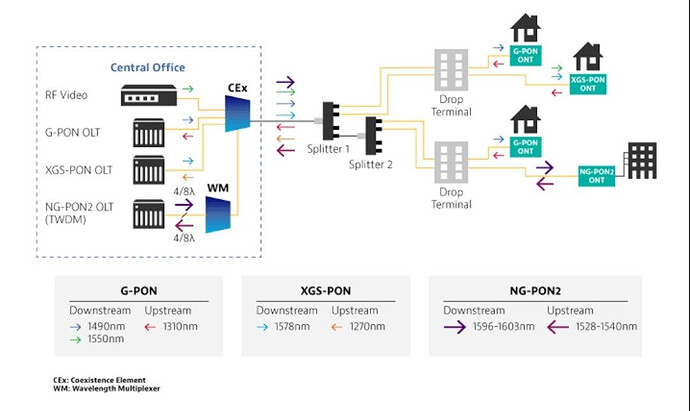PON (Passive Optical Network) technologies come with a set of terminologies that are essential to understand when working with or discussing PON networks. Here are some key PON terminologies:
-
OLT (Optical Line Terminal):
- The central device in a PON network located at the service provider’s central office. It communicates with multiple ONUs/ONTs.
-
ONU (Optical Network Unit) / ONT (Optical Network Terminal):
- These terms are sometimes used interchangeably. ONUs/ONTs are devices located at the customer premises that receive and transmit data over the optical network.
-
Splitter:
- A passive optical device that divides the incoming optical signal from the OLT into multiple output signals, each sent to different ONUs/ONTs.
-
Upstream:
- Data transmission from ONUs/ONTs to the OLT. Also known as the “transmit” direction.
-
Downstream:
- Data transmission from the OLT to ONUs/ONTs. Also known as the “receive” direction.
-
Triple Play:
- The delivery of three primary services over a single PON infrastructure: voice (VoIP), video (IPTV), and data (high-speed internet).
-
DBA (Dynamic Bandwidth Allocation):
- A technique used in PON networks to allocate available bandwidth dynamically among ONUs based on their traffic requirements.
-
GPON (Gigabit Passive Optical Network):
- A specific PON standard defined by ITU-T G.984, capable of delivering high-speed data, voice, and video services.
-
EPON (Ethernet Passive Optical Network):
- A PON standard that uses Ethernet protocol for data transmission, often used in broadband and enterprise applications.
-
Burst Mode Transmission:
- A technique where ONUs transmit data in bursts to the OLT only when there’s data to send, optimizing bandwidth usage.
-
FEC (Forward Error Correction):
- Error correction technique used in PON systems to enhance data integrity by adding redundant information to the transmitted data.
-
SNR (Signal-to-Noise Ratio):
- A measure of the quality of the optical signal, indicating the strength of the useful signal compared to the background noise.
These terminologies are essential for anyone involved in designing, deploying, or maintaining PON networks. Understanding them helps ensure effective communication and successful implementation of PON technology.
LinkedIn: ![]()
